Autumn 2021. In theory we could travel to other continents, but destinations we had in mind such as Japan or the United Kingdom were impossible to plan ahead. Instead we organised a rail trip to Eastern Europe, travelling to Berlin, Gdańsk, Wrocław, Karlovy Vary, Pilsen, Bratislava, Poprad, Vienna, Linz and Salzburg. By travelling to Germany, Poland, Czechia, Slovakia and Austria, we explore an area which was in the (not too distant) past bonded together by the Holy Roman Empire of the German Nation and by Austria-Hungary.
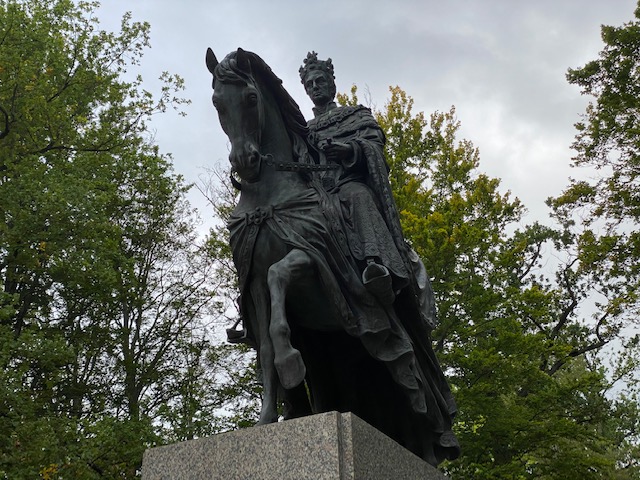
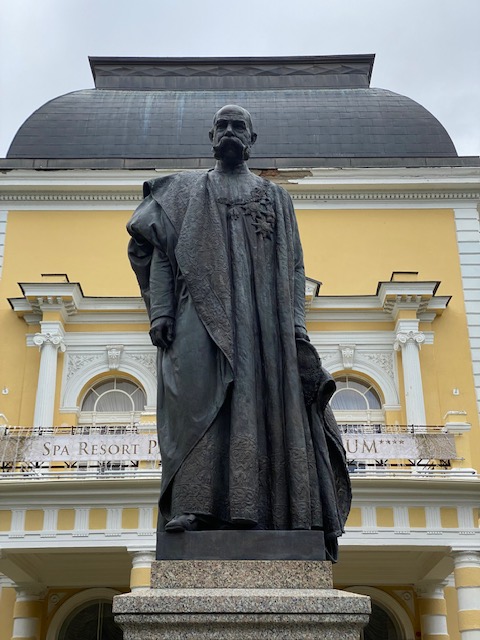
After spending a day in Karlovy Vary, Sam, Danny and I did an excursion to Františkovy Lázně or Franzensbad.
Františkovy Lázně is a spa town in Cheb District in the Karlovy Vary Region of the Czech Republic. It has about 5,400 inhabitants. Together with neighbouring Karlovy Vary and Mariánské Lázně, it is part of the renowned West Bohemian Spa Triangle.
The town centre is well preserved and since 1992 has been protected by law as an urban monument reservation. In 2021, the town became part of the transnational UNESCO World Heritage Site under the name ‘Great Spa Towns of Europe‘ because of its famous natural springs and its architectural testimony to the popularity of spa towns across Europe in the 18th through 20th centuries.
The town is located in the Egerland region near the border with Germany. It is situated in the Ohře river basin, north of the regional capital Cheb.





History
The salutary effects of the surrounding springs were known from the late 14th century on. Physician Georgius Agricola (1494–1555) mentioned the mineral water available to Cheb citizens.
Around 1705 an inn was erected at the site of a mineral spring later known as Franzensquelle.
In 1793, the town was officially founded under the name Kaiser Franzensdorf, after Emperor Francis II, and later renamed Franzensbad, under which name it became a famous spa (Bad).
The spa was founded by Eger-based doctor Bernhard Adler (1753–1810).[4] He promoted the expansion of spa facilities and the accommodation for those seeking healing and promoted the transformation of the swampy moorland with paths and footbridges to well-known sources. The town was laid out around 24 springs in an orthogonal plan.



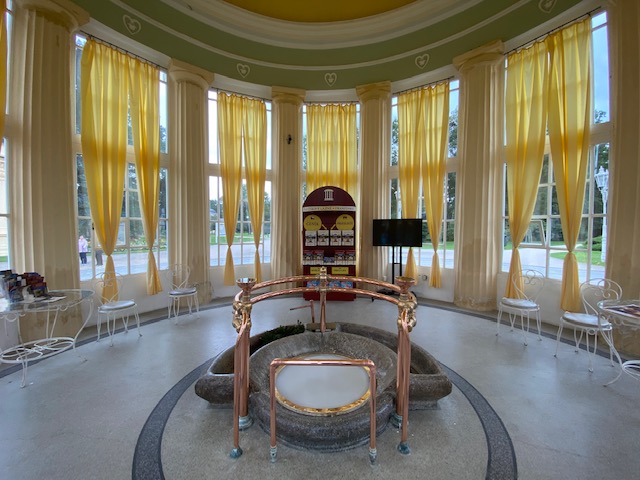
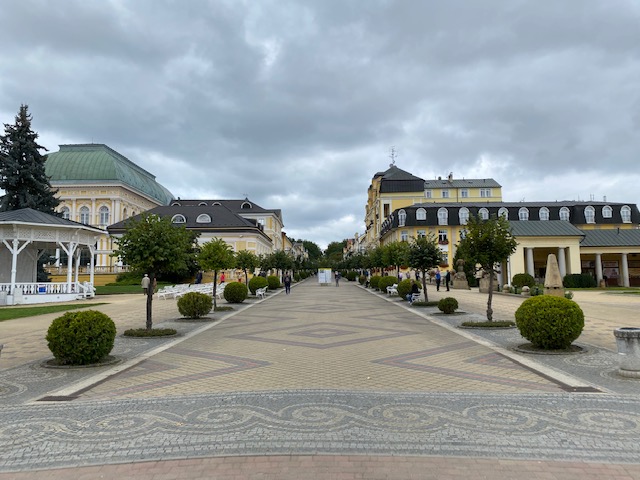

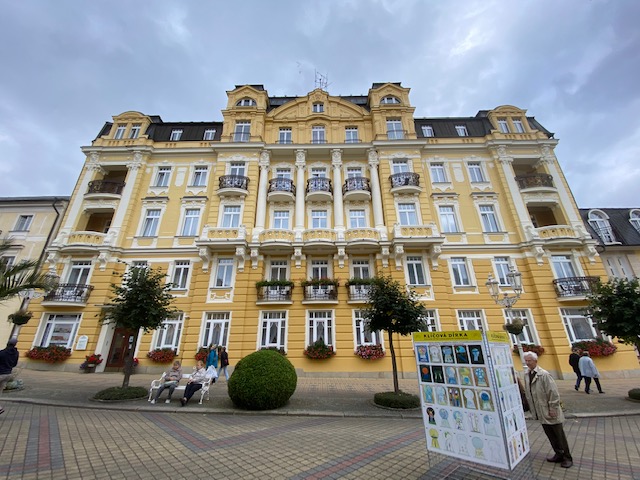
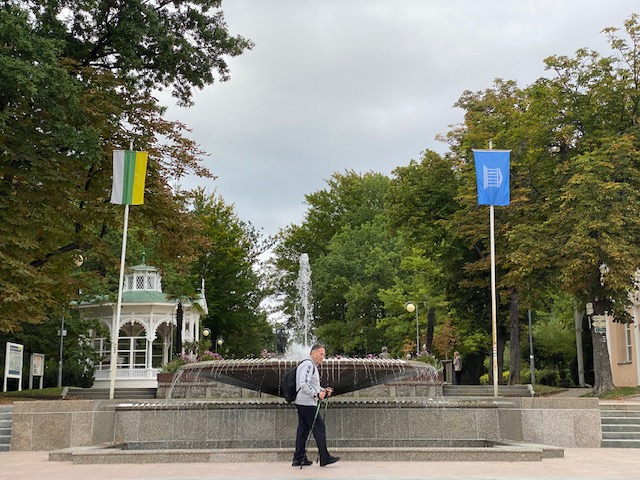

Destruction
When in 1791 Adler had a pavilion and a water basin erected at the Franzensquelle, he sparked the Egerer Weibersturm (“Women’s storm of Eger”) by numerous women who earned their livelihood in the scooping, transport and sale of the water in Eger.
Feeling their water-bearing rights threatened, they demolished his premises.
The town council of Eger intervened and made the extension of Franzensbad as a health resort possible.
The result was an extensive recreation area, with easy access from the city of Cheb. Johann Wolfgang von Goethe was one of the most famous guests in the early days. Another famous visitor was Ludwig van Beethoven.
During the 19th century, patients included numerous aristocrats, especially Russian nobles, and at the same time widely known doctors bolstered the reputation of Franzensbad as a therapeutic resort. Franzensbad offered one of the first peat pulp baths in Europe, popular especially with female guests.
A public spa house was built in 1827. The writer Marie von Ebner-Eschenbach portrayed her stay in her early work ‘Aus Franzensbad‘ in 1858. Other notable guests included Theodor Herzl (in 1904), Emperor Francis Joseph I of Austria and Emperor Charles I of Austria.
In 1862, Franzensbad became an autonomous municipality and obtained town privileges three years later. Until 1918 it was part of the Bohemian crown land of the Austro-Hungarian monarchy.

After 1918
After World War I, the town’s reputation began to fade. Then part of the new state of Czechoslovakia, the spa lost much of its patronage and was hit hard by the Great Depression of 1929.
After World War II, the German-speaking population was expelled under the Beneš decrees.
Many of them settled in Bayreuth in Bavaria. The spa, officially renamed Františkovy Lázně in Czech, was nationalized under the rule of the Communist Party. After the Velvet Revolution of 1989, a stock company was established to revive the status of Františkovy Lázně as a venue for international guests.
Twenty-three out of the 24 springs in the town are actively used.
Belle Epoque
Františkovy Lázně has many yellow neoclassical and Belle Epoque buildings of the Habsburg era, as well as by extended parks and gardens with numerous springs and bathhouses.
The Social House is the dominant feature of the spa centre. It was built in 1877 in neo-renaissance style. It is the venue of congresses, balls and other social events and the building also houses a casino.
The Theatre of Božena Němcová was built in the current area in 1868. New theatre building was built in neoclassical style in 1927–1928 and interiors were decorated in Art Deco style.
The town has two museums: the Town Museum and a small Museum of Motorcycles and Cars.
Aquaforum
The main reason we went to Františkovy Lázně was actually to spend some time at Aquaforum. Not a quite a thermal bath or hot spring, it is still a huge swimming pool complex with different pools inside and outdoor, whirlpools, a water slide and a tobogan.
While not spectacular, it was a nice aquacomplex. Obvipusly I don’t have inside photos.
Walk around town
After the pool we walked around the park and the city centre. We entered one of the sanatorium and it looked like throwback to the olden days. I felt like bing in an epoque film.
It reminded me of Potsdam, but less fancy. Františkovy Lázně is very proud of being recognized by UNESCO. There are UNESCO flags everywhere.
Visiting Františkovy Lázně was a nice excursion, but Karlovy Vary is in a better state and more lively.
Resources: Wikipedia.
2021 Rail Tour of Imperial Europe
- POTSDAM 2021 | Schloss Sanssouci.
- 1945 Potsdam Conference’s Cecilienhof Palace.
- Potsdam 2021.
- REVIEW | InterContinental Berlin.
- BERLIN 2021 | Pergamon, ‘Das Panorama’.
- BERLIN 2021 | Humboldt Forum in the Berlin Palace.
- BERLIN 2021 | The Bundestag in the Reichstag.
- Berlin 2021.
- By train from Berlin to Gdansk via Szczecin.
- Stopover in Szczecin.
- REVIEW | Restauracja Ritz in Gdańsk.
- REVIEW | Holiday Inn Gdansk.
- GDAŃSK | Museum of the Second World War.
- GDAŃSK | European Solidarity Centre or Europejskie Centrum Solidarności.
- A walk through Gdańsk.
- Gdańsk 2021.
- POLAND | PKP Intercity Gdansk to Wroclaw via Warsaw.
- Wrocław Museum of Architecture.
- The Dwarfs of Wrocław.
- Wrocław.
- Poland 2021.
- By train from Wroclaw to Karlovy Vary.
- Karlovy Vary.
- REVIEW | Hotel Imperial Karlovy Vary.

Wow! Wonderful and interesting post! Beautiful place! Thank’s for share, Timothy.
Nice Sunday!
Elvira
LikeLiked by 1 person
Thank you Elvira. Have a great Sunday!
LikeLiked by 1 person
You are welcome, Timothy.
Nice Sunday too!
LikeLiked by 1 person